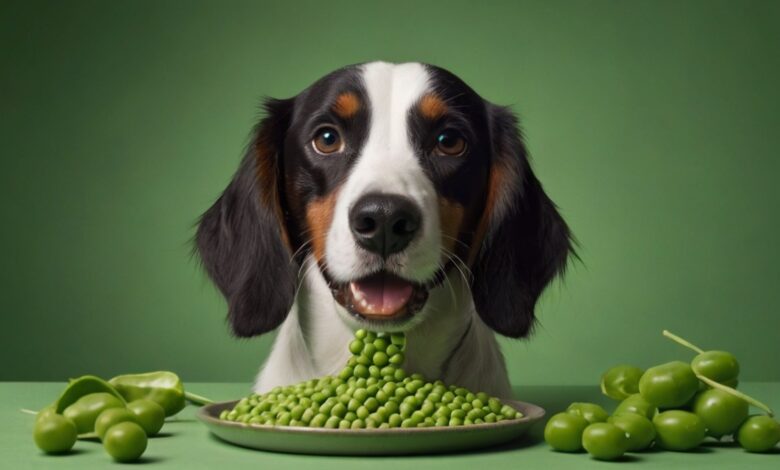Can Dogs Eat Green Peas Safely? A Complete Guide for Dog Owners-2024

Can Dogs Eat Green Peas Safely? Yes, green peas are generally safe for dogs to eat in moderation. They can be a tasty and nutritious treat that offers a variety of health benefits. Fresh, frozen, or steamed peas are the best options for your furry friend.
However, it’s important to avoid canned peas since they often contain added salt and preservatives that can be harmful. In this article, we’ll dive into the benefits and potential risks of feeding green peas to your dog, ensuring you make the best choices for their diet. Let’s briefly discuss that-can dogs eat green peas safely?
Understanding the Nutritional Benefits
When it comes to dog nutrition, many pet owners wonder, can dogs eat green peas safely? The answer is a resounding yes! Green peas are not only safe for most dogs but also offer several nutritional benefits that can contribute positively to their overall health. Let’s explore some of these benefits to understand why you might consider adding green peas to your dog’s diet.
Packed with Essential Vitamins
- Vitamin A: This vitamin is crucial for maintaining good vision and a healthy immune system.
- Vitamin B Complex: These vitamins help support your dog’s metabolism and promote energy levels.
- Vitamin K: Important for proper blood clotting and bone health.
- Vitamin C: While dogs can produce their own vitamin C, additional sources can help with immune function.
Good Source of Dietary Fiber
- Aids Digestion: The fiber in green peas helps to regulate your dog’s digestive system, promoting regular bowel movements and preventing constipation.
- Feeling Full: Fiber can also help your dog feel fuller for longer, which may be beneficial if you’re managing their weight.
Provides Plant-Based Proteins
- Muscle Health: Green peas contain protein that supports muscle development and repair. This is particularly important for active dogs or those in recovery from surgery or injury.
- Nutrient-Rich Alternative: While meat is a primary protein source for dogs, green peas offer a healthy plant-based option to diversify their diet.
Contains Lutein and Antioxidants
- Healthy Skin and Eyes: Lutein is beneficial for maintaining eye health, and antioxidants can help reduce oxidative stress and promote healthy skin.
- Immune Support: Antioxidants in green peas can boost your dog’s immune function, helping them fend off illness.
You can confidently answer the question, can dogs eat green peas safely, knowing they are not only safe but also provide essential vitamins, fiber, proteins, and antioxidants. Including green peas in your dog’s diet can be a smart choice for their overall health. Just remember to serve them in moderation and consult your veterinarian if you have any concerns about your dog’s specific dietary needs.
How to Properly Serve Green Peas to Your Dog
If you’re considering adding green peas to your dog’s diet, you might be wondering, can dogs eat green peas safely? Absolutely! Green peas can be a nutritious and tasty addition to your dog’s meals, but it’s important to serve them correctly. Knowing how to prepare and present peas will help your furry friend enjoy all the benefits without any unwanted additives.
Serve Peas Plain
- No Added Salt or Spices: Keep it simple! Seasoning can upset your dog’s stomach, so serve green peas plain.
- Avoid Butter: While butter might seem tempting, it can be high in fat and isn’t necessary for flavor.
Choose Fresh or Frozen Peas
- Fresh Peas: They are packed with nutrients and have the best texture. Just make sure to wash them before serving.
- Frozen Peas: These are a convenient option. They retain most of their nutrients and can be thawed for easy serving.
- Steamed or Mashed: Lightly steaming or mashing peas can make them easier for your dog to digest. This preparation method can help unlock their nutrients while ensuring your dog can chew them comfortably.
Mix Peas into Regular Food
- Occasional Treat: Green peas can be mixed into your dog’s regular meals as an occasional treat. This adds variety to their diet and can be a fun way to introduce new flavors.
- Watch Portion Sizes: Remember, moderation is key! Use peas as a supplement rather than a replacement for their regular food.
By following these simple serving tips, you can confidently include green peas in your dog’s diet. So yes, can dogs eat green peas safely? With the right preparation, the answer is a resounding yes! Just ensure you follow these guidelines to keep your furry friend healthy and happy.
Potential Risks of Feeding Green Peas to Dogs
Can Dogs Eat Green Peas Safely? While green peas can offer many health benefits for your dog, it’s important to be aware of potential risks. So, can dogs eat green peas safely without issues? For most dogs, yes, but certain precautions are necessary, especially if your dog has specific health conditions. Let’s explore some of the potential risks to ensure your dog stays happy and healthy when enjoying green peas.
High in Purines
- Kidney Issues: Green peas are naturally high in purines, compounds that can break down into uric acid. For dogs with kidney problems or certain types of urinary conditions, these purines may aggravate their condition.
- Sensitive Dogs: If your dog is prone to kidney issues, it’s best to limit or avoid feeding them peas. Always consult your vet before introducing green peas into their diet.
Gas and Bloating
- Fiber Content: Green peas contain a good amount of fiber, which is great for digestion in moderate amounts. However, too many peas can cause gas or bloating, especially in larger quantities.
- Moderation is Key: Start by feeding small amounts of peas and see how your dog’s digestive system reacts before making them a regular part of their diet.
Gradual Introduction
- Allergic Reactions: Just like with any new food, it’s important to introduce green peas gradually. Some dogs may have sensitivities or allergies to certain foods, and peas are no exception.
- Watch for Symptoms: After introducing peas, monitor your dog for signs of allergic reactions like itching, swelling, or digestive upset. If any of these occur, stop feeding peas and contact your vet.
Can dogs eat green peas safely? Yes, they can, but make sure you keep these risks in mind, especially if your dog has a sensitive stomach or pre-existing health issues. By feeding peas in moderation and keeping an eye on their reaction, you can avoid these potential problems while still providing your dog with a healthy treat.
Recommended Portion Sizes for Different Dog Breeds
When considering whether can dogs eat green peas safely, it’s essential to keep portion sizes in mind. While green peas can be a nutritious treat, how much you feed your dog can make all the difference in their health. Let’s break down the recommended portion sizes based on your dog’s breed and size.
Small Dogs
- Serving Size: Small dogs can enjoy green peas in moderation, typically ranging from 1 teaspoon to 1 tablespoon as a treat.
- Treat Time: Use this portion as a special reward during training or as an occasional snack. This helps keep their diet balanced without overwhelming their small stomachs.
Medium Dogs
- Serving Size: For medium-sized dogs, aim for 1 to 2 tablespoons of green peas. You can mix these into their regular food to enhance their meal.
- Balanced Diet: Ensure that these peas complement their overall diet without replacing essential nutrients. Mixing them with other healthy ingredients can keep their meals exciting.
Large Dogs
- Serving Size: Large dogs can have a bit more, enjoying up to 3 tablespoons of green peas, depending on their overall diet and activity level.
- Diet Considerations: Since larger dogs often require more calories, this portion size should still fit within a balanced diet. Keep an eye on their weight and health to adjust portions as needed.
Can dogs eat green peas safely? Absolutely, but it’s crucial to pay attention to portion sizes. By following these guidelines, you can treat your dog to the benefits of green peas while ensuring they stay healthy and happy. Always remember to monitor their reactions and consult your veterinarian if you have any concerns about their diet.
Healthier Vegetable Alternatives for Dogs-Can Dogs Eat Green Peas Safely?
Can Dogs Eat Green Peas Safely? If you’re looking for nutritious treats for your furry friend, you might wonder about healthier vegetable alternatives to green peas. While green peas are safe for dogs in moderation, there are other options that can provide similar health benefits without any potential risks. Let’s explore some fantastic alternatives that can keep your dog happy and healthy!
Carrots
- Crunchy Treat: Carrots make a great crunchy snack that most dogs love.
- Nutritional Benefits: They are low in calories and high in beta-carotene, which is good for your dog’s eyesight and overall health.
- Serving Tips: Serve them raw or cut into bite-sized pieces for easy munching.
Sweet Potatoes
- Nutrient-Rich: Sweet potatoes are packed with vitamins and minerals, making them a great addition to your dog’s diet.
- Digestive Aid: They are also good for digestion, providing fiber that helps keep things moving smoothly.
- Serving Tips: Cook and mash or slice them into cubes for your dog to enjoy.
Green Beans
- Weight Management: Green beans offer a low-calorie, fiber-rich option that can help with weight management.
- Health Benefits: They are also full of vitamins and minerals that support your dog’s health.
- Serving Tips: Fresh or frozen green beans can be served plain or mixed with your dog’s regular food.
Spinach
- Iron Boost: Spinach is rich in iron and vitamins, which can be beneficial for your dog’s overall health.
- Feeding Guidelines: However, it should be fed in small amounts due to its oxalate content, which can interfere with calcium absorption.
- Serving Tips: Lightly cook or steam spinach to make it easier for your dog to digest.
In conclusion, while can dogs eat green peas safely, incorporating these healthier vegetable alternatives can provide variety and nutrition in your dog’s diet. Always remember to introduce new foods gradually and consult your veterinarian if you have any concerns about your dog’s diet or specific health issues. By doing so, you can ensure that your furry friend enjoys a balanced and healthy diet!




